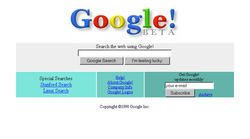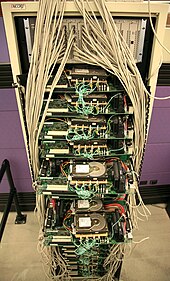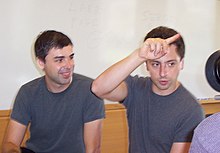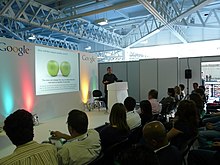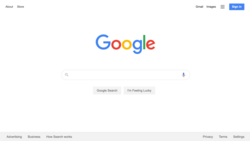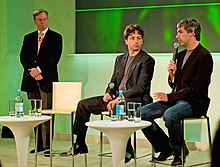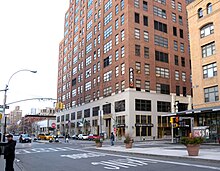 |
Google is an American multinational corporation specializing in Internet-related services and products. These include online advertising technologies, search, cloud computing, and software.[6] Most of its profits are derived from AdWords.
Google was founded by Larry Page and Sergey Brin while they were Ph.D. students at Stanford University. Together they own about 16 percent of its shares. They incorporated Google as a privately held company on September 4, 1998. An initial public offering followed on August 19, 2004. Its mission statement from the outset was "to organize the world's information and make it universally accessible and useful",[9] and its unofficial slogan was "Don't be evil".[10][11] In 2006 Google moved to headquarters in Mountain View, California, nicknamed theGoogleplex.
Rapid growth since incorporation has triggered a chain of products, acquisitions and partnerships beyondGoogle's core search engine. It offers online productivity software including email (Gmail), an office suite (Google Drive), and social networking (Google+). Desktop products include applications for web browsing, organizing andediting photos, and instant messaging. The company leads the development of the Android mobile operating system and the browser-only Chrome OS[12] for a netbook known as a Chromebook. Google has moved increasingly into communications hardware: it partners with major electronics manufacturers in production of its high-end Nexus devices and acquired Motorola Mobility in May 2012.[13] In 2012, a fiber-optic infrastructure was installed in Kansas City to facilitate a Google Fiber broadband service.[14]
The corporation has been estimated to run more than one million servers in data centers around the world (as of 2007)[15] and to process over one billion search requests[16] and about 24 petabytes of user-generated data each day (as of 2009).[17][18][19][20] In December 2013 Alexa listed google.com as the most visited website in the world. Numerous Google sites in other languages figure in the top one hundred, as do several other Google-owned sites such as YouTube and Blogger.[21] Its market dominance has led to prominent media coverage, including criticism of the company over issues such as copyright, censorship, and privacy.
History
Main article: History of Google
Google began in January 1996 as a research project by Larry Page and Sergey Brin when they were both PhD students at Stanford University in Stanford, California.[25]
While conventional search engines ranked results by counting how many times the search terms appeared on the page, the two theorized about a better system that analyzed the relationships between websites.[26] They called this new technology PageRank; it determined a website's relevance by the number of pages, and the importance of those pages, that linked back to the original site.[27][28]
A small search engine called "RankDex" from IDD Information Services designed by Robin Li was, since 1996, already exploring a similar strategy for site-scoring and page ranking.[29] The technology in RankDex would be patented[30] and used later when Li founded Baidu in China.[31][32]
Page and Brin originally nicknamed their new search engine "BackRub", because the system checked backlinks to estimate the importance of a site.[33][34][35] Eventually, they changed the name to Google, originating from a misspelling of the word "googol",[36][37] the number one followed by one hundred zeros, which was picked to signify that the search engine was intended to provide large quantities of information.[38] Originally, Google ran under Stanford University's website, with the domains google.stanford.edu and z.stanford.edu.[39][40]
The domain name for Google was registered on September 15, 1997,[41] and the company was incorporated on September 4, 1998. It was based in a friend's (Susan Wojcicki[25]) garage in Menlo Park, California. Craig Silverstein, a fellow PhD student at Stanford, was hired as the first employee.[25][42][43]
In May 2011, the number of monthly unique visitors to Google surpassed one billion for the first time, an 8.4 percent increase from May 2010 (931 million).[44] In January 2013, Google announced it had earned US$50 billion in annual revenue for the year of 2012. This marked the first time the company had reached this feat, topping their 2011 total of US$38 billion.[45]
Financing and initial public offering
The first funding for Google was an August 1998 contribution of US$100,000 from Andy Bechtolsheim, co-founder of Sun Microsystems, given before Google was incorporated.[47] Early in 1999, while graduate students, Brin and Page decided that the search engine they had developed was taking up too much time and distracting their academic pursuits. They went to Excite CEO George Bell and offered to sell it to him for US$1 million. He rejected the offer and later criticized Vinod Khosla, one of Excite's venture capitalists, after he negotiated Brin and Page down to $750,000. On June 7, 1999, a $25 million round of funding was announced,[48] with major investors including the venture capital firms Kleiner Perkins Caufield & Byers and Sequoia Capital.[47]
Google's initial public offering (IPO) took place five years later on August 19, 2004. At that time Larry Page, Sergey Brin, and Eric Schmidt agreed to work together at Google for 20 years, until the year 2024.[49] The company offered 19,605,052 shares at a price of $85 per share.[50][51] Shares were sold in an online auction format using a system built by Morgan Stanley and Credit Suisse, underwriters for the deal.[52][53] The sale of $1.67 billion gave Google a market capitalization of more than $23 billion.[54] By January 2014, its market capitalization had grown to $397 billion.[55] The vast majority of the 271 million shares remained under the control of Google, and many Google employees became instant paper millionaires. Yahoo!, a competitor of Google, also benefited because it owned 8.4 million shares of Google before the IPO took place.[56]
There were concerns that Google's IPO would lead to changes in company culture. Reasons ranged from shareholder pressure for employee benefit reductions to the fact that many company executives would become instant paper millionaires.[57] As a reply to this concern, co-founders Sergey Brin and Larry Page promised in a report to potential investors that the IPO would not change the company's culture.[58] In 2005, articles in The New York Times and other sources began suggesting that Google had lost its anti-corporate, no evil philosophy.[59][60][61][62] In an effort to maintain the company's unique culture, Google designated a Chief Culture Officer, who also serves as the Director of Human Resources. The purpose of the Chief Culture Officer is to develop and maintain the culture and work on ways to keep true to the core values that the company was founded on: a flat organization with a collaborative environment.[63] Google has also faced allegations of sexism and ageism from former employees.[64][65]
The stock performed well after the IPO, with shares hitting $700 for the first time on October 31, 2007,[66] primarily because of strong sales and earnings in theonline advertising market.[67] The surge in stock price was fueled mainly by individual investors, as opposed to large institutional investors and mutual funds.[67] The company is listed on the NASDAQ stock exchange under the ticker symbol GOOG and on the Frankfurt Stock Exchange under the ticker symbol GGQ1.
Growth
In March 1999, the company moved its offices to Palo Alto, California, which is home to several prominent Silicon Valley technology startups.[68] The next year, against Page and Brin's initial opposition toward an advertising-funded search engine,[69] Google began selling advertisements associated with search keywords.[25]In order to maintain an uncluttered page design and increase speed, advertisements were solely text-based. Keywords were sold based on a combination of price bids and click-throughs, with bidding starting at five cents per click.[25]
This model of selling keyword advertising was first pioneered by Goto.com, an Idealab spin-off created by Bill Gross.[70][71] When the company changed names to Overture Services, it sued Google over alleged infringements of the company's pay-per-click and bidding patents. Overture Services would later be bought by Yahoo! and renamed Yahoo! Search Marketing. The case was then settled out of court; Google agreed to issue shares of common stock to Yahoo! in exchange for a perpetual license.[72]
In 2001, Google received a patent for its PageRank mechanism.[73] The patent was officially assigned to Stanford University and lists Lawrence Page as the inventor. In 2003, after outgrowing two other locations, the company leased an office complex from Silicon Graphics at 1600 Amphitheatre Parkway in Mountain View, California.[74] The complex became known as the Googleplex, a play on the word googolplex, the number one followed by a googol zeroes. The Googleplex interiors were designed by Clive Wilkinson Architects. Three years later, Google bought the property from SGI for $319 million.[75] By that time, the name "Google" had found its way into everyday language, causing the verb "google" to be added to the Merriam-Webster Collegiate Dictionary and the Oxford English Dictionary, denoted as "to use the Google search engine to obtain information on the Internet."[76][77]
2013 onward
Google announced the launch of a new company called Calico on September 19, 2013, which will be led by Apple chairman Arthur Levinson. In the official public statement, Page explained that the "health and wellbeing" company will focus on "the challenge of ageing and associated diseases".[78]
As of September 2013, Google operates 70 offices in more than 40 countries.[79] Google celebrated its 15-year anniversary on September 27, 2013, although it has used other dates for its official birthday.[80] The reason for the choice of September 27 remains unclear, and a dispute with rival search engine Yahoo! Search in 2005 has been suggested as the cause.[81][82]
The Alliance for Affordable Internet (A4AI) was launched in October 2013 and Google is part of the coalition of public and private organisations that also includesFacebook, Intel and Microsoft. Led by Sir Tim Berners-Lee, the A4AI seeks to make Internet access more affordable so that access is broadened in the developing world, where only 31% of people are online. Google will help to decrease internet access prices so that they fall below the UN Broadband Commission's worldwide target of 5% of monthly income.[83]
The corporation's consolidated revenue for the third quarter of 2013 is reported in mid-October 2013 as US$14.89 billion, a 12 percent increase compared to the previous quarter. Google's Internet business was responsible for US$10.8 billion of this total, with an increase in the number of users' clicks on advertisements.[84]
In November 2013, Google announced plans for a new 1-million-sq-ft (93,000 sq m) office in London, which is due to open in 2016. The new premises will be able to accommodate 4,500 employees and has been identified as one of the biggest ever commercial property acquisitions in Britain.[85]
Acquisitions and partnerships
Since 2001, Google has acquired many companies, primarily small venture capital-funded firms. In 2004, Google acquiredKeyhole, Inc.[86] The start-up company developed a product called Earth Viewer that gave a three-dimensional view of the Earth. Google renamed the service to Google Earth in 2005. Google acquired Urchin Software in April 2005, using their 'Urchin on Demand' product (along with ideas from Adaptive Path's 'Measure Map') to create Google Analytics in 2006.
In October 2006, Google announced that it had acquired the video-sharing site YouTube for US$1.65 billion in Google stock, and the deal was finalized on November 13, 2006.[87] Google does not provide detailed figures for YouTube's running costs, and YouTube's revenues in 2007 were noted as "not material" in a regulatory filing.[88] In June 2008, a Forbes magazine article projected the 2008 YouTube revenue at US$200 million, noting progress in advertising sales.[89]
On April 13, 2007, Google reached an agreement to acquire DoubleClick for $3.1 billion, giving Google valuable relationships that DoubleClick had with Web publishers and advertising agencies.[90] Later that same year, Google purchased GrandCentral for $50 million.[91] The site would later be changed over to Google Voice. On August 5, 2009, Google bought out its first public company, purchasing video software maker On2 Technologies for $106.5 million.[92] Google also acquired Aardvark, a social network search engine, for $50 million, and commented on its internal blog, "we're looking forward to collaborating to see where we can take it".[93] In April 2010, Google announced it had acquired a hardware startup, Agnilux.[94]
In addition to the many companies Google has purchased, the company has partnered with other organizations for research, advertising, and other activities. In 2005, Google partnered with NASA Ames Research Center to build 1,000,000 square feet (93,000 m2) of offices.[95] The offices would be used for research projects involving large-scale data management, nanotechnology, distributed computing, and the entrepreneurial space industry. Google entered into a partnership with Sun Microsystems in October 2005 to help share and distribute each other's technologies.[96]
The company also partnered with AOL[97] to enhance each other's video search services. Google's 2005 partnerships also included financing the new .mobi top-level domain for mobile devices, along with other companies including Microsoft, Nokia, and Ericsson.[98] Google would later launch "AdSense for Mobile", taking advantage of the emerging mobile advertising market.[99] Increasing its advertising reach even further, Google and Fox Interactive Media of News Corporationentered into a $900 million agreement to provide search and advertising on the then-popular social networking site MySpace.[100]
In 2007, Google began sponsoring NORAD Tracks Santa, displacing former sponsor AOL. NORAD Tracks Santa purports to follow Santa Claus' progress on Christmas Eve,[101] using Google Earth to "track Santa" in 3-D for the first time.[102] Google-owned YouTube gave NORAD Tracks Santa its own channel.[103]
In 2008, Google developed a partnership with GeoEye to launch a satellite providing Google with high-resolution (0.41 m monochrome, 1.65 m color) imagery for Google Earth. The satellite was launched from Vandenberg Air Force Base on September 6, 2008.[104] Google also announced in 2008 that it was hosting an archive of Life Magazine's photographs. Some of the images in the archive were never published in the magazine.[105] The photos were watermarked and originally had copyright notices posted on all photos, regardless of public domain status.[106]
In 2010, Google Energy made its first investment in a renewable energy project, putting $38.8 million into two wind farms in North Dakota. The company announced the two locations will generate 169.5 megawatts of power, enough to supply 55,000 homes. The farms, which were developed by NextEra Energy Resources, will reduce fossil fuel use in the region and return profits. NextEra Energy Resources sold Google a twenty-percent stake in the project to get funding for its development.[107] In February 2010, the Federal Energy Regulatory Commission FERC granted Google an authorization to buy and sell energy at market rates.[108]The order specifically states that Google Energy—a subsidiary of Google—holds the rights "for the sale of energy, capacity, and ancillary services at market-based rates", but acknowledges that neither Google Energy nor its affiliates "own or control any generation or transmission" facilities.[109] The corporation exercised this authorization in September 2013 when it announced that it will purchase all of the electricity produced by the not-yet-built 240-megawatt Happy Hereford wind farm.[110]
Also in 2010, Google purchased Global IP Solutions, a Norway-based company that provides web-based teleconferencing and other related services. This acquisition enabled Google to add telephone-style services to its list of products.[111] On May 27, 2010, Google announced it had also closed the acquisition of the mobile ad network AdMob. This occurred days after the Federal Trade Commission closed its investigation into the purchase.[112] Google acquired the company for an undisclosed amount.[113] In July 2010, Google signed an agreement with an Iowa wind farm to buy 114 megawatts of energy for 20 years.[114]
On April 4, 2011, The Globe and Mail reported that Google bid $900 million for six thousand Nortel Networks patents.[115]
On August 15, 2011, Google made its largest-ever acquisition to-date when announced that it would acquire Motorola Mobility for $12.5 billion[116][117] subject to approval from regulators in the United States and Europe. In a post on Google's blog, Google Chief Executive and co-founder Larry Page revealed that the acquisition was a strategic move to strengthen Google's patent portfolio. The company's Android operating system has come under fire in an industry-wide patent battle, as Apple and Microsoft have sued Android device makers such as HTC, Samsung, and Motorola.[118] The merger was completed on the May 22, 2012, after the approval of People's Republic of China.[119]
This purchase was made in part to help Google gain Motorola's considerable patent portfolio on mobile phones and wireless technologies to help protect it in its ongoing patent disputes with other companies,[120] mainly Apple and Microsoft[118] and to allow it to continue to freely offer Android.[121] After the acquisition closed, Google began to restructure the Motorola business to fit Google's strategy. On August 13, 2012, Google announced plans to layoff 4000 Motorola Mobility employees.[122] On December 10, 2012, Google sold the manufacturing operations of Motorola Mobility to Flextronics for $75 million.[123] As a part of the agreement, Flextronics will manufacture undisclosed Android and other mobile devices.[124] On December 19, 2012, Google sold the Motorola Home business division of Motorola Mobility to Arris Group for $2.35 billion in a cash-and-stock transaction. As a part of this deal, Google acquired a 15.7% stake in Arris Group valued at $300 million.[125]
On June 5, 2012, Google announced it acquired Quickoffice, a company widely known for their mobile productivity suite for both iOS and Android. Google plans to integrate Quickoffice's technology into its own product suite.[126]
On February 6, 2013, Google announced it had acquired Channel Intelligence for $125 million. Channel Intelligence, a technology company that helps customers buy products online, is active globally in 31 different countries and works with over 850 retailers. Google will use this technology to enhance its e-commerce business.[127]
The official confirmation of Google's acquisition of the Israel-based startup Waze occurred in June 2013. Waze is promoted as a "community-based traffic and navigation app".[128]
Following the acquisition of Waze, Google submitted a "10-Q" filing with the Securities Exchange Commission (SEC) that revealed that the corporation spent US$1.3 billion on acquisitions during the first half of 2013. The filing also revealed that the Waze acquisition cost Google US$966 million, instead of the US$1.1 billion figure that was initially presented in media sources.[128][129][130]
The 2012 acquisition of WIMM Labs, a company that previously made an Android-powered smartwatch, was confirmed in August 2013. As of August 31, 2013, Google has not publicly commented on the news concerning WIMM Labs.[131] The acquisition of Flutter, a creator of hand gesture recognition technology, was confirmed by the corporation in early October 2013. The reported price is US$40 million and Google spokesperson stated: "We're really impressed by the Flutter team's ability to design new technology based on cutting-edge research." Flutter's technology allows users to enact hand gestures to control navigation for apps such as iTunes, Windows Media Player, and Winamp.[132]
On January 26, 2014 Google Inc. announced it had agreed to acquire DeepMind Technologies, a privately held artificial intelligence company from London. DeepMind describes themselves as having the ability to combine the best techniques from machine learning and systems neuroscience to build general-purpose learning algorithms. DeepMind’s first commercial applications were used in simulations, e-commerce and games. As of December 2013, it was reported that DeepMind had roughly 75 employees.[133] The technology news website Re/code reported that the company was purchased for $400 million though it was not disclosed where the information came from. A Google spokesman would not comment of the price.[134][135]The purchase of DeepMind aids in Google's recent growth in the artificial intelligence and robotics community.[136]
On January 29, 2014, Google announced it was selling its Motorola Mobility unit to China-based Lenovo, for $2.91B. The company kept the extensive patent collection used to develop Android products, considered the most valuable part of the original deal.[136]
In March 2014, Google confirmed it had purchased the remnants of gaming startup, Green Throttle Games, which developed a Bluetooth gaming controller for Android.[137]
In May 2014, Google announced it had purchased Quest Visual, maker of the augmented reality translator app Word Lens: image-based translation works with iOS, Android, Glass.[138]
Google data centers
As of 2011, Google Inc. owned and operated six data centers across the U.S., one in Finland and another in Belgium. On September 28, 2011, the company announced plans to build three data centers at a cost of more than $200 million in Asia (Singapore, Hong Kong and Taiwan) and purchased the land for them. Google said they would be operational within two years.[139][140]
In October 2013, The Washington Post reported that the U.S. National Security Agency intercepted communications between Google's data centers, as part of a program named MUSCULAR.[141][142] This wiretapping was made possible because Google did not encrypt data passed inside its own network.[143] Google began encrypting data sent between data centers in 2013.[144]
Products and services
See also: List of Google products
Advertising
For the 2006 fiscal year, the company reported $10.492 billion in total advertising revenues and only $112 million in licensing and other revenues.[145] In 2011, 96% of Google's revenue was derived from its advertising programs.[146] Using technology from the company DoubleClick, Google can determine user interests and target advertisements so they are relevant to their context and the user that is viewing them.[147][148]
Google Analytics allows website owners to track where and how people use their website, for example by examining click rates for all the links on a page.[149] Google advertisements can be placed on third-party websites in a two-part program. Google'sAdWords allows advertisers to display their advertisements in the Google content network, through either a cost-per-click or cost-per-view scheme. The sister service, Google AdSense, allows website owners to display these advertisements on their website and earn money every time ads are clicked.[150]
One of the criticisms of this program is the possibility of click fraud, which occurs when a person or automated script clicks on advertisements without being interested in the product, causing the advertiser to pay money to Google unduly. Industry reports in 2006 claimed that approximately 14 to 20 percent of clicks were fraudulent or invalid.[151]
In February 2003, Google stopped showing the advertisements of Oceana, a non-profit organization protesting a major cruise ship's sewage treatment practices. Google cited its editorial policy at the time, stating "Google does not accept advertising if the ad or site advocates against other individuals, groups, or organizations."[152] The policy was later changed.[153] In June 2008, Google reached an advertising agreement with Yahoo!, which would have allowed Yahoo! to feature Google advertisements on its web pages. The alliance between the two companies was never completely realized because of antitrust concerns by the U.S. Department of Justice. As a result, Google pulled out of the deal in November 2008.[154][155]
In an attempt to advertise its own products, Google launched a website called Demo Slam, developed to demonstrate technology demos of Google Products.[156]
Search engine
Main article: Google Search
According to market research published by comScore in November 2009, Google Search is the dominant search engine in the United States market, with a market share of 65.6%.[157] Google indexes billions[158] of web pages, so that users can search for the information they desire through the use of keywords and operators.
In 2003, The New York Times complained about Google's indexing, claiming that Google's caching of content on its site infringed its copyright for the content.[159] In this case, the United States District Court of Nevada ruled in favor of Google in Field v. Google and Parker v. Google.[160][161] The publication 2600: The Hacker Quarterly has compiled a list of words that the web giant's new instant search feature will not search.[162]
Google Watch has criticized Google's PageRank algorithms, saying that they discriminate against new websites and favor established sites.[163] The site has also alleged that there are connections between Google and the National Security Agency (NSA) and the Central Intelligence Agency (CIA).[164]
Google also hosts Google Books. The company began scanning books and uploading limited previews, and full books where allowed, into its new book search engine. The Authors Guild, a group that represents 8,000 U.S. authors, filed a class action suit in a New York City federal court against Google in 2005 over this service. Google replied that it is in compliance with all existing and historical applications of copyright laws regarding books.[165] Google eventually reached a revised settlement in 2009 to limit its scans to books from the U.S., the UK, Australia, and Canada.[166] Furthermore, the Paris Civil Court ruled against Google in late 2009, asking it to remove the works of La Martinière (Éditions du Seuil) from its database.[167] In competition with Amazon.com, Google sells digital versions of new books.[168]
On July 21, 2010, in response to Bing, Google updated its image search to display a streaming sequence of thumbnails that enlarge when pointed at. Though web searches still appear in a batch per page format, on July 23, 2010, dictionary definitions for certain English words began appearing above the linked results for web searches.[169]
The "Hummingbird" update to the Google search engine was announced in September 2013. The update was introduced over the month prior to the announcement and allows users ask the search engine a question in natural language rather than entering keywords into the search box.[170]
Productivity tools
Gmail, a free webmail service provided by Google, was launched as an invitation-only beta program on April 1, 2004,[171] and became available to the general public on February 7, 2007.[172] The service was upgraded from beta status on July 7, 2009,[173] at which time it had 146 million users monthly.[174] The service was the first online email service with one gigabyte of storage. It was also the first to keep emails from the same conversation together in one thread, similar to an Internet forum.[171] The service offers over 15 GB of free storage, shared with other Google Apps, with additional storage ranging from 20 GB to 16 TB available for US$0.25per 1 GB per year.[175]
Gmail uses AJAX, a programming technique that allows web pages to be interactive without refreshing the browser.[176] Steve Ballmer (Microsoft's former CEO),[177]Liz Figueroa,[178] Mark Rasch,[179] and the editors of Google Watch[180] have criticised the privacy of Gmail, but Google claims that mail sent to or from Gmail is never read by a human being beyond the account holder and is only used to improve relevance of advertisements.[181]
In 2004, Google started opensource software project hosting, called Google Code, which allows developers to download incomplete programs at no charge. Google Docs, another part of Google's productivity suite, allows users to create, edit, and collaborate on documents in an online environment, similar to Microsoft Word. The service was originally called Writely, but was obtained by Google on March 9, 2006, and was released as an invitation-only preview.[182] On June 6 after the acquisition, Google created an experimental spreadsheet editing program,[183] which was combined with Google Docs on October 10.[184]
Enterprise products
Google Search Appliance was launched in February 2002, targeted toward providing search technology for larger organizations.[25] Google launched the Mini three years later, which was targeted at smaller organizations. Late in 2006, Google began to sell Custom Search Business Edition, providing customers with an advertising-free window into Google.com's index. The service was renamed Google Site Search in 2008.[185]
Google Apps allows organizations to bring Google's web application offerings, such as Gmail and Google Docs, into their own domains. The service is available in several editions: a basic free edition (formerly known as Google Apps Standard edition), Google Apps for Business, Google Apps for Education, and Google Apps for Government. In the same year Google Apps was launched, Google acquired Postini[186]and proceeded to integrate the company's security technologies into Google Apps[187] under the name Google Postini Services.[188]
Other products
Google Translate is a server-side machine translation service, which can translate between 35 different languages. The software usescorpus linguistics techniques, where the program "learns" from professionally translated documents, specifically UN and European Parliament proceedings.[189]
Google launched its Google News service in 2002, an automated service which summarizes news articles from various websites.[190] In March 2005, Agence France Presse (AFP) sued Google for copyright infringement in federal court in the District of Columbia, a case which Google settled for an undisclosed amount in a pact that included a license of the full text of AFP articles for use on Google News.[191]
In 2006, Google made a bid to offer free wireless broadband access throughout the city of San Francisco along with Internet service provider EarthLink. Large telecommunications companies such as Comcast and Verizon opposed the efforts, claiming it was "unfair competition" and that cities would be violating their commitments to offer local monopolies to these companies. In his testimony before Congress on network neutrality in 2006, Google's Chief Internet Evangelist Vint Cerf blamed the tactics on the fact that nearly half of all consumers lack choice in broadband providers.[192] Google currently offers free wi-fi access in its hometown of Mountain View, California.[193]
In 2010, Google announced the Google Fiber project with plans to build an ultra-high-speed broadband network for 50,000 to 500,000 customers in one or more American cities.[194] On March 30, 2011, Google announced that Kansas City, Kansas would be the first community where the new network would be deployed.[195] In July 2012, Google completed the construction of a fiber-optic broadband internet network infrastructure in Kansas City, and after building an infrastructure, Google announced pricing for Google Fiber. The service will offer three options including a free broadband internet option, a 1Gbit/s internet option for $70 per month, and a version that includes television service for $120 per month.[14]
In 2007, reports surfaced that Google was planning the release of its own mobile phone, possibly a competitor to Apple's iPhone.[196][197][198] The project, calledAndroid, turned out not to be a phone but an operating system for mobile devices, which Google acquired and then released as an open source project under theApache 2.0 license.[199] Google provides a software development kit for developers so applications can be created to be run on Android-based phones. In September 2008, T-Mobile released the G1, the first Android-based phone.[200] On January 5, 2010, Google released an Android phone under its own company name called the Nexus One.[201] A report in July 2013 stated that Google's share of the global smartphone market, led by Samsung products, was 64% in March 2013.[202]
Other projects Google has worked on include a new collaborative communication service, a web browser, and a mobile operating system. The first of these was first announced on May 27, 2009. The company described Google Wave as a product that helps users communicate and collaborate on the web. The service is Google's "email redesigned", with realtime editing, the ability to embed audio, video, and other media, and extensions that further enhance the communication experience. Google Wave was initially in a developer's preview, where interested users had to be invited to test the service, but was released to the general public on May 19, 2010, at Google's I/O keynote. On September 1, 2008, Google pre-announced the upcoming availability of Google Chrome, an open source web browser,[203] which was then released on September 2, 2008. On July 7, 2009, Google announced Google Chrome OS, an open source Linux-based operating system that includes only a web browser and is designed to log users into their Google account.[204][205]
Google Goggles is a mobile application available on Android and iOS used for image recognition and non-text-based search. In addition to scanning QR codes, the app can recognize historic landmarks, import business cards, and solve Sudoku puzzles.[206] While Goggles could originally identify people as well, Google has limited that functionality as a privacy protection.[207]
In 2011, Google announced Google Wallet, a mobile application for wireless payments.[208] In late June 2011, Google soft-launched a social networking servicecalled Google+.[209] On July 14, 2011, Google announced that Google+ had reached 10 million users just two weeks after it was launched in this "limited" trial phase.[210] After four weeks in operation, it reached 25 million users.[211]
At a launch event on July 24, 2013, in San Francisco, U.S., a newer version of the Nexus 7 Google tablet device was released to the public, alongside theChromecast dongle that allows users to stream YouTube and Netflix videos via smartphones.[212]
In 2013 Google launched Google Shopping Express, a delivery service initially available only in San Francisco and Silicon Valley.[213]
On February 3, 2014, Google released its first Chromecast SDK.[214]
Corporate affairs and culture
On Fortune magazine's list of best companies to work for, Google ranked first in 2007, 2008 and 2012[215][216][217] and fourth in 2009 and 2010.[218][219] Google was also nominated in 2010 to be the world's most attractive employer to graduating students in the Universum Communications talent attraction index.[220] Google's corporate philosophy includes principles such as "you can make money without doing evil," "you can be serious without a suit," and "work should be challenging and the challenge should be fun."[221]
Employees
As of 2013, Google had 47,756 employees (in the fourth quarter, including the Motorola subsidiary),[5] among them more than 10,000 software developers based in more than 40 offices.[222]
After the company's IPO in 2004, founders Sergey Brin and Larry Page and CEO Eric Schmidt requested that their base salary be cut to $1. Subsequent offers by the company to increase their salaries were turned down, primarily because their main compensation continues to come from owning stock in Google. Before 2004, Schmidt made $250,000 per year, and Page and Brin each received an annual salary of $150,000.[223]
In 2007 and early 2008, several top executives left Google. In October 2007, former chief financial officer of YouTube Gideon Yu joined Facebook[224] along with Benjamin Ling, a high-ranking engineer.[225] In March 2008, Sheryl Sandberg, then vice-president of global online sales and operations, began her position as chief operating officer of Facebook.[226] At the same time, Ash ElDifrawi, formerly head of brand advertising, left to become chief marketing officer of Netshops.[227] On April 4, 2011, Larry Page became CEO and Eric Schmidt became Executive Chairman of Google.[228] In July 2012, Google's first female employee, Marissa Mayer, left Google to become Yahoo!'s CEO.[229]
As a motivation technique, Google uses a policy often called Innovation Time Off, where Google engineers are encouraged to spend 20% of their work time on projects that interest them. Some of Google's newer services, such as Gmail, Google News, Orkut, and AdSense originated from these independent endeavors.[231] In a talk at Stanford University, Marissa Mayer, Google's Vice President of Search Products and User Experience until July 2012, showed that half of all new product launches in the second half of 2005 had originated from the Innovation Time Off.[232]
Googleplex
Main article: Googleplex
Google's headquarters in Mountain View, California, is referred to as "the Googleplex", a play on words on the number googolplexand the headquarters itself being a complex of buildings. The lobby is decorated with a piano, lava lamps, old server clusters, and a projection of search queries on the wall. The hallways are full of exercise balls and bicycles. Many employees have access to the corporate recreation center. Recreational amenities are scattered throughout the campus and include a workout room with weights and rowing machines, locker rooms, washers and dryers, a massage room, assorted video games, table football, a baby grand piano, a billiard table, and ping pong. In addition to the recreation room, there are snack rooms stocked with various foods and drinks, with special emphasis placed on nutrition.[233] Free food is available to employees 24/7, with the offerings provided by paid vending machines prorated based on and favoring those of better nutritional value.[234]
Google's extensive amenities are not available to all of its workers. Temporary workers such as book scanners do not have access to shuttles, Google cafes, or other perks.[235]
In 2006, Google moved into 311,000 square feet (28,900 m2) of office space in New York City, at 111 Eighth Avenue in Manhattan.[236] The office was specially designed and built for Google and houses its largest advertising sales team, which has been instrumental in securing large partnerships.[236] The New York headquarters is similar in design and functionality to its Mountain View headquarters, and includes a game room, micro kitchens, and a video game area.[237] As of February 2012, a significant engineering team is based in New York City.[238] As of September 2013, Google's East Coast office is located at 76 Ninth Ave, New York City, New York.[239]
In November 2006, Google opened offices on Carnegie Mellon's campus in Pittsburgh, focusing on shopping-related advertisement coding and smartphone applications and programs.[240][241]
By late 2006, Google also established a new headquarters for its AdWords division in Ann Arbor, Michigan.[242] Other office locations in the U.S. include Ann Arbor, Michigan; Atlanta, Georgia; Austin, Texas; Boulder, Colorado; Cambridge, Massachusetts; New York City; San Francisco, California; Seattle, Washington; Reston, Virginia, and Washington, D.C.Furthermore, Google has several international offices.
In October 2006, the company announced plans to install thousands of solar panels to provide up to 1.6 megawatts of electricity, enough to satisfy approximately 30% of the campus' energy needs.[243] The system will be the largest solar power system constructed on a U.S. corporate campus and one of the largest on any corporate site in the world.[243] In addition, Google announced in 2009 that it was deploying herds of goats to keep grassland around the Googleplex short, helping to prevent the threat from seasonal bush fires while also reducing the carbon footprint of mowing the extensive grounds.[244][245] The idea of trimming lawns using goats originated from R. J. Widlar, an engineer who worked for National Semiconductor.[246] In 2008, Google faced accusations in Harper's Magazine of being an "energy glutton". The company was accused of employing its "Don't be evil" motto and its public energy-saving campaigns to cover up or make up for the massive amounts of energy its servers require.[247]
Easter eggs and April Fools' Day jokes
Main article: List of Google's hoaxes and easter eggs
Google has a tradition of creating April Fools' Day jokes. On April 1, 2000, Google MentalPlex allegedly featured the use of mental power to search the web.[248] In 2007, Google announced a free Internet service called TiSP, or Toilet Internet Service Provider, where one obtained a connection by flushing one end of a fiber-optic cable down their toilet.[249] Also in 2007, Google's Gmail page displayed an announcement for Gmail Paper, allowing users to have email messages printed and shipped to them.[250] In 2008, Google announced Gmail Custom time where users could change the time that the email was sent.[251]
In 2010, Google changed its company name to Topeka in honor of Topeka, Kansas, whose mayor changed the city's name to Google for a short amount of time in an attempt to sway Google's decision in its new Google Fiber Project.[252][253] In 2011, Google announced Gmail Motion, an interactive way of controlling Gmail and the computer with body movements via the user's webcam.[254]
Google's services contain easter eggs, such as the Swedish Chef's "Bork bork bork," Pig Latin, "Hacker" or leetspeak, Elmer Fudd, Pirate, and Klingon as language selections for its search engine.[255] The search engine calculator provides theAnswer to the Ultimate Question of Life, the Universe, and Everything from Douglas Adams' The Hitchhiker's Guide to the Galaxy.[256] When searching the word "recursion", the spell-checker's result for the properly spelled word is exactly the same word, creating a recursive link.[257]
When searching for the word "anagram," meaning a rearrangement of letters from one word to form other valid words, Google's suggestion feature displays "Did you mean: nag a ram?"[258] In Google Maps, searching for directions between places separated by large bodies of water, such as Los Angeles and Tokyo, results in instructions to "kayak across thePacific Ocean." During FIFA World Cup 2010, search queries including "World Cup" and "FIFA" caused the "Goooo...gle" page indicator at the bottom of every result page to read "Goooo...al!" instead.[259]
Philanthropy
Main article: Google.org
In 2004, Google formed the not-for-profit philanthropic Google.org, with a start-up fund of $1 billion.[260] The mission of the organization is to create awareness about climate change, global public health, and global poverty. One of its first projects was to develop a viable plug-in hybrid electric vehicle that can attain 100 miles per gallon. Google hired Larry Brilliant as the program's executive director in 2004,[261] and the current director is Megan Smith.[262]
In 2008 Google announced its "project 10100" which accepted ideas for how to help the community and then allowed Google users to vote on their favorites.[263]After two years of silence, during which many wondered what had happened to the program,[264] Google revealed the winners of the project, giving a total of ten million dollars to various ideas ranging from non-profit organizations that promote education to a website that intends to make all legal documents public and online.[265]
In 2011, Google donated 1 million euros to International Mathematical Olympiad to support the next five annual International Mathematical Olympiads (2011–2015).[266] On July 2012, Google launched a "Legalize Love" campaign in support of gay rights.[267]
Tax avoidance
Google uses various tax avoidance strategies. Out of the five largest American technology companies it pays the lowest taxes to the countries of origin of its revenues. The company accomplishes this partly by licensing technology through subsidiaries in Ireland, Bermuda, the Bahamas, and the Netherlands.[268] This has reportedly sparked a French investigation into Google's transfer pricing practices.[269]
Following criticism of the amount of corporate taxes that Google paid in the United Kingdom, Chairman Eric Schmidt said, "It's called capitalism. We are proudly capitalistic." During the same December 2012 interview Schmidt "confirmed that the company had no intention of paying more to the UK exchequer."[270] In 2013, Schmidt responded to questions about taxes paid in the UK by pointing to the advertising fees Google charged UK companies as a source of economic growth.[271]
Google Vice President Matt Brittin testified to the Public Accounts Committee of the UK House of Commons that his UK sales team made no sales and hence owed no sales taxes to the UK.[272]
Environment
Since 2007, Google has aimed for carbon neutrality in regard to its operations.[273][274] Google disclosed in September 2011 that it "continuously uses enough electricity to power 200,000 homes", almost 260 million watts or about a quarter of the output of a nuclear power plant. Total carbon emissions for 2010 were just under 1.5 million metric tons, most due to fossil fuels that provide electricity for the data centers. Google said that 25 percent of its energy was supplied by renewable fuels in 2010. An average search uses only 0.3 watt-hours of electricity, so all global searches are only 12.5 million watts or 5% of the total electricity consumption by Google[275]
In June 2013, the Washington Post reported that Google had donated US$50,000 to the Competitive Enterprise Institute, a libertarian think tank that calls human carbon emissions a positive factor in the environment and argues that global warming is not a concern.[276]
In July 2013, it was reported that Google had hosted a fundraising event for Oklahoma Senator Jim Inhofe, who has called climate change a "hoax".[277]
Lobbying
In 2013, Google ranked 5th in lobbying spending, up from 213th in 2003
